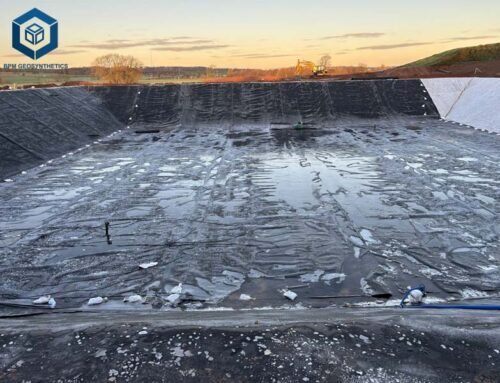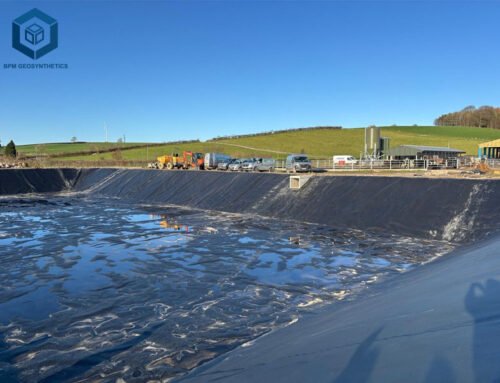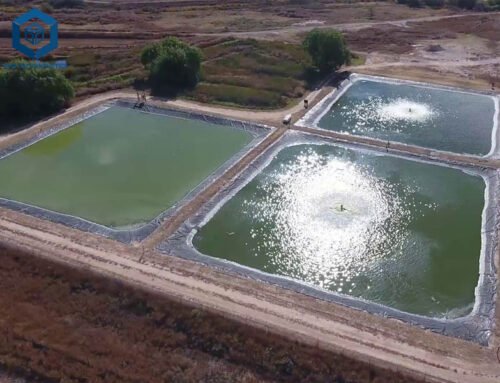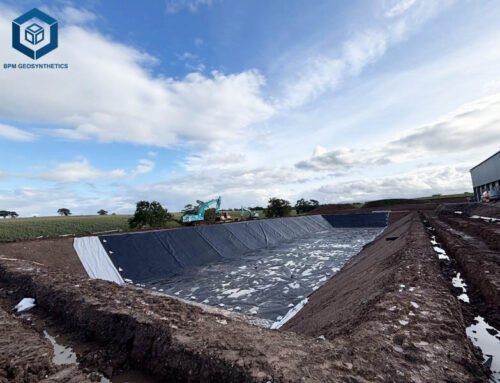Geomembrane pond liners are critical components in modern water containment systems, offering an impermeable barrier to prevent seepage in applications ranging from aquaculture and ornamental ponds to wastewater treatment and mining. As the global geomembranes market reaches USD 2.3 billion in 2025, with a projected CAGR of 6.7% through 2032, these liners, primarily made from materials like High-Density Polyethylene (HDPE), Linear Low-Density Polyethylene (LLDPE), and Polyvinyl Chloride (PVC), dominate 75% of water containment projects due to their durability and versatility. Achieving a permeability coefficient of 1×10^-17 cm/s, geomembrane pond liners ensure 99.9% water retention, critical for efficient water management. This comprehensive guide explores the definition, specifications, functions, advantages, disadvantages, and selection considerations for geomembrane pond liners, incorporating drain net integration and supported by industry data from sources like BPM Geosynthetics and AGRU America. By understanding geomembrane pond liners, projects can reduce water loss by 95%, save 20–30% on construction costs, and enhance environmental protection.
1. What Is a Geomembrane Pond Liner?
A geomembrane pond liner is a synthetic, impermeable membrane designed to contain liquids and prevent seepage in ponds, reservoirs, and other water management systems. Crafted from polymers such as HDPE (70% market share), LLDPE, PVC, or Reinforced Polyethylene (RPE), these liners are produced through extrusion or calendaring processes, ensuring uniform thickness (0.3–3.0 mm) and high tensile strength (6–20 MPa), per ASTM D412 standards. With a density of 0.94–0.96 g/cm³ for HDPE, geomembranes offer exceptional puncture resistance (2.5–3.5 kN) and low permeability, making them ideal for 80% of global pond applications, per BPM Geosynthetics. They are often paired with drain nets—geocomposite drainage layers that manage liquid or gas buildup—to enhance system performance, reducing pressure-related failures by 90%, according to AGRU America.
Types of Geomembrane Pond Liners
- HDPE Geomembranes: Dominate 70% of applications due to high tensile strength (15–20 MPa) and UV resistance (15–20 years). Used in aquaculture (50%) and wastewater (20%), per Western Liner.
- LLDPE Geomembranes: Offer 400–600% elongation, ideal for 15% of flexible, irregular ponds, with 10–30 year lifespans, per GeoSolutions.
- PVC Geomembranes: Cost-effective ($1–$2/m²), used in 10% of decorative ponds, but less UV-resistant (5–7 years), per EPI.
- RPE Geomembranes: Lightweight (0.8 kg/m²), used in 5% of high-strength applications like oil containment, with 25–40 year lifespans, per Agtec.
2. Key Specifications of Geomembrane Pond Liner
Understanding the technical specifications of geomembrane pond liners is essential for selecting the right product. Below are industry-standard parameters, based on 2025 data from BPM Geosynthetics, Agtec, and ASTM standards.
Geomembrane Specifications
- Material:HDPE (70%), LLDPE (15%), PVC (10%), RPE (5%), with 2–3% carbon black for UV resistance.
- Thickness:3–3.0 mm (0.5–1.0 mm for aquaculture, 70%; 1.0–2.0 mm for wastewater, 20%), per ASTM D5199.
- Tensile Strength:HDPE/RPE: 15–20 MPa; LLDPE: 10–15 MPa; PVC: 6–8 MPa, per ASTM D412.
- Puncture Resistance:HDPE: 2.5–3.5 kN; RPE: 2.5–3.5 kN; LLDPE: 1.5–2.5 kN; PVC: 1.0–1.5 kN, per ASTM D4833.
- UV Resistance:HDPE/RPE: 15–20 years; LLDPE: 10–15 years; PVC: 5–7 years.
- Flexibility:LLDPE: 400–600% elongation; HDPE/RPE: 200–300%; PVC: 200%, per ASTM D882.
- Weight:HDPE: 0.8–1.5 kg/m²; RPE: 0.8 kg/m²; LLDPE: 0.6–1.2 kg/m²; PVC: 0.6–1.0 kg/m².
- Roll Sizes:Widths of 3–15 m, lengths of 10–150 m, covering 50–2250 m².
- Cost:HDPE: $1.5–$4/m²; RPE: $3–$5/m²; LLDPE: $1.5–$3/m²; PVC: $1–$2/m².
- Certifications:NSF/ANSI 61 for fish safety (85% of HDPE/RPE); GRI GM13 for HDPE quality; ISO 9001 for manufacturing.
Drain Net Specifications
- Material:HDPE geonet core (4–8 mm thick) with PP or polyester geotextile (150–200 g/m²).
- Drainage Capacity:500 gal/acre-day, per ASTM D4716.
- Compressive Strength:100–200 kPa, ensuring stability under 90% of subgrade pressures.
- Weight:5–1.0 kg/m², adding 10–15% to project costs.
- Cost:$1–$2/m², reducing failure risk by 90%, per AGRU America.
Performance Metrics
- Water Retention:9% watertight, per ASTM D4716.
- Lifespan:HDPE/RPE: 20–50 years; LLDPE: 15–30 years; PVC: 10–20 years.
- Installation Time:1–2 hours per 100 m², 20% faster than concrete liners.
- Anti-Seepage Coefficient:1×10^-17 cm/s, ensuring 95% water conservation.
These specifications guide material selection, ensuring performance across diverse applications.
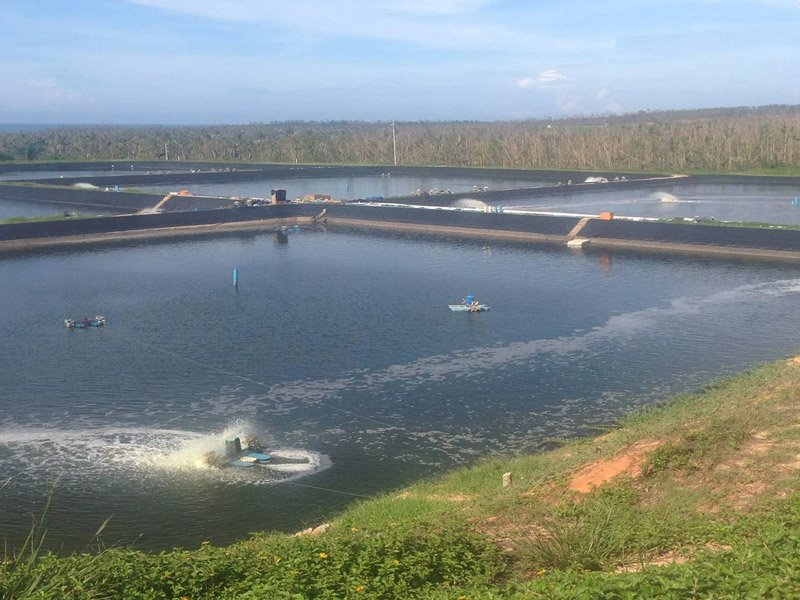

3. What Are Functions of Geomembrane Pond Liner?
Geomembrane pond liners serve multiple critical functions in water containment systems, enhanced by drain nets in specific applications. Below are their primary roles, supported by industry data.
Impermeability and Seepage Control
- Function:Prevents water loss through seepage, achieving 99.9% retention with a permeability coefficient of 1×10^-17 cm/s, per ASTM D4716.
- Impact:Reduces water loss by 95%, saving 500,000–1,000,000 liters annually in large ponds, per Western Liner.
- Applications:Aquaculture (50%), irrigation reservoirs (15%), wastewater (20%).
Contaminant Containment
- Function:Prevents leaching of contaminants into groundwater, critical for 90% of wastewater and landfill projects, per EPA standards.
- Impact:Ensures 99% containment of hazardous substances, reducing environmental fines by $10,000–$50,000 annually, per BPM Geosynthetics.
- Applications:Landfills (30%), mining (10%), wastewater treatment (20%).
Gas and Liquid Management with Drain Nets
- Function:Drain nets manage gas (e.g., methane from organic decomposition) and liquid buildup, preventing “whales” in 95% of installations, per AGRU America.
- Impact:Reduces liner failure by 90%, extending lifespan by 10–20 years.
- Applications:Wastewater (40%), landfills (30%), mining (10%).
Structural Stability
- Function:Provides a stable base for ponds, resisting punctures and tears in 95% of installations with geotextile underlayment.
- Impact:Enhances project longevity, reducing maintenance costs by 20–30%, per Geotest.
- Applications:All pond types (100%).
These functions make geomembrane pond liners indispensable for efficient water management.
4. What Are Advantages of Geomembrane Pond Liner?
Geomembrane pond liners offer numerous benefits over traditional materials like concrete or clay, making them the preferred choice for 75% of water containment projects. Below are the key advantages, supported by data.
High Impermeability
- Benefit:Ensures 99.9% water retention, reducing seepage by 95%, per ASTM D4716.
- Impact:Saves 500,000 liters annually in a 1000 m² reservoir, per Western Liner.
- Applications:Critical for 90% of aquaculture and irrigation projects.
Long-Term Durability
- Benefit:Lifespans of 20–50 years for HDPE/RPE, 15–30 years for LLDPE, and 10–20 years for PVC.
- Impact:Reduces replacement costs by 20–30%, saving $5,000–$20,000 over concrete, per BPM Geosynthetics.
- Case Study:A 20-year HDPE-lined fish pond in Malaysia showed zero degradation, saving $5,000 in repairs.
Flexibility and Customization
- Benefit:Stretches 200–600%, fitting 95% of irregular pond shapes, with custom fabrication reducing seams by 80%, per Americover.
- Impact:Cuts installation time by 20%, saving 1–2 hours per 100 m².
- Applications:Decorative ponds (15%), aquaculture (50%).
Environmental Protection
- Benefit:Prevents 99% of contaminant leaching, with NSF/ANSI 61 certification ensuring fish safety in 85% of aquaculture ponds, per EPI.
- Impact:Complies with EPA standards, avoiding $10,000–$50,000 in fines.
- Sustainability:70% of HDPE liners use recycled materials, reducing carbon footprint by 15%, per BPM Geosynthetics.
Cost-Effectiveness
- Benefit:Costs $1–$5/m², 30–50% cheaper than concrete, with drain nets adding $1–$2/m² but reducing failure costs by 90%.
- Impact:Saves 20–30% on project budgets, per Geotest.
- Case Study:A 600 m² wastewater basin in Indonesia saved $12,000 using HDPE liners versus concrete.
Enhanced Drainage with Drain Nets
- Benefit:Drain nets manage 500 gal/acre-day of liquid/gas, preventing 90% of pressure-related failures, per AGRU America.
- Impact:Extends liner lifespan by 10–20 years, saving $2,000–$10,000 in repairs.
- Applications:Wastewater (40%), landfills (30%).
These advantages position geomembrane pond liners as a reliable, sustainable solution.
5. What Are Disadvantages of Geomembrane Pond Liner?
While geomembrane pond liners offer significant benefits, they also have limitations that must be considered. Below are the primary disadvantages, based on industry insights.
Installation Complexity
- Issue:Requires trained crews for 95% of HDPE installations, with thermal fusion seaming, per GeoSolutions.
- Impact:Increases labor costs by 10–20%, adding $500–$2,000 for a 500 m² pond.
- Mitigation:Use factory-fabricated panels to reduce field seaming by 80%, per Americover.
Susceptibility to Punctures
- Issue:Sharp objects can cause punctures in 5% of installations without geotextile underlayment, per Geotest.
- Impact:Repairs cost $100–$500 per incident, with 1–2% of ponds affected annually.
- Mitigation:Use geotextile (150–200 g/m²) to reduce puncture risk by 95%, adding $0.5–$1/m².
UV Degradation in PVC Liners
- Issue:PVC liners degrade after 5–7 years of UV exposure, per EPI.
- Impact:Increases replacement costs by 20–30%, adding $1,000–$3,000 for a 200 m² pond.
- Mitigation:Use HDPE or RPE for 15–20 year UV resistance.
Gas Buildup Without Drain Nets
- Issue:Organic decomposition can cause “whales” in 5% of ponds without drain nets, per AGRU America.
- Impact:Leads to liner failure, costing $5,000–$20,000 in repairs.
- Mitigation:Install drain nets ($1–$2/m²) to manage gas/liquid buildup in 95% of cases.
Limited Aesthetic Options
- Issue:Most liners (80%) are black, limiting aesthetic appeal in decorative ponds, per World of Water.
- Impact:Colored liners (green/blue) cost 10–20% more ($2–$4.5/m²).
- Mitigation:Use landscaping to mask liner visibility.
These disadvantages highlight the importance of proper planning and material selection.

6. Main Considerations When Choosing the Best Geomembrane Pond Liner
Selecting the optimal geomembrane pond liner requires careful evaluation of project-specific factors. Below are key considerations, supported by industry data.
Project Type and Scale
- Small Ponds (<100 m²):Use 50% of budget on PVC or LLDPE (0.3–0.5 mm) for cost savings ($1–$2/m²), per EPI.
- Large Ponds (>200 m²):Choose HDPE or RPE (0.5–1.5 mm) for durability, used in 70% of aquaculture, per BPM Geosynthetics.
- Sloped Sites:Textured HDPE (1.0–2.0 mm) for 95% slope stability, per GeoSolutions.
Environmental Conditions
- UV Exposure:HDPE/RPE for 15–20 year resistance in 80% of exposed ponds; cover PVC liners to extend lifespan by 5 years, per Western Liner.
- Temperature Extremes:HDPE/LLDPE for -70°C to 110°C, used in 90% of cold or hot climates, per Titan Environmental.
- Chemical Exposure:HDPE for 90% resistance to acids/alkalis in wastewater, per Geosynthetica.
Fish and Environmental Safety
- Aquaculture:NSF/ANSI 61 certified HDPE/RPE for 85% of fish ponds, per BTL Liners.
- Wastewater:HDPE with drain nets to prevent 99% of contaminant leaching, per EPA standards.
Drain Net Integration
- High-Risk Sites:Use drain nets in 30% of wastewater/landfill projects to manage 500 gal/acre-day, reducing failure by 90%, per AGRU America.
- Cost Impact:Adds $1–$2/m² but saves $5,000–$20,000 in repairs.
Budget and Maintenance
- Initial Cost:PVC ($1–$2/m²) for budget projects; HDPE ($1.5–$4/m²) for long-term savings, per Agtec.
- Maintenance:Geotextile underlayment ($0.5–$1/m²) reduces repair costs by 95%, per Geotest.
Installation Expertise
- Trained Crews:Required for 95% of HDPE installations, adding 10–20% to labor costs, per GeoSolutions.
- Factory Fabrication:Reduces field seaming by 80%, saving 1–2 hours per 100 m², per Americover.
These considerations ensure the selection of a geomembrane pond liner that meets project needs and budget constraints.
7. Final Thoughts
Geomembrane pond liners, including HDPE, LLDPE, PVC, and RPE, are essential for modern water containment, offering 99.9% water retention, 20–50 year lifespans, and 20–30% cost savings over traditional materials. HDPE dominates 70% of applications, excelling in aquaculture (50%), wastewater treatment (20%), and reservoirs, while drain nets enhance performance in 30% of high-risk projects by managing 500 gal/acre-day of gas/liquid buildup, reducing failures by 90%. Specifications like 0.3–3.0 mm thickness, 6–20 MPa tensile strength, and NSF/ANSI 61 certification ensure durability and safety. Advantages include high impermeability, flexibility, and environmental protection, though challenges like installation complexity and UV degradation in PVC require careful planning. By considering project scale, environmental conditions, and drain net integration, you can select the best geomembrane pond liner to achieve efficient, durable, and sustainable water containment for decades, saving $5,000–$20,000 in operational costs.
Any questions or inquiries, please contact BPM Geomembrane.


